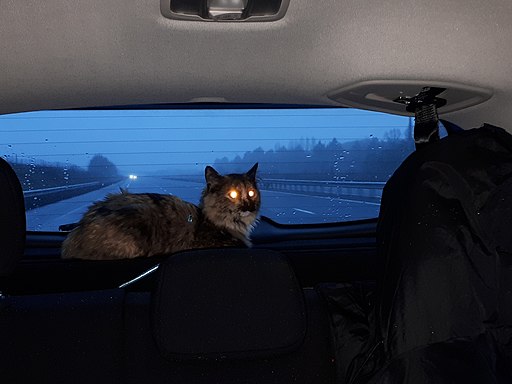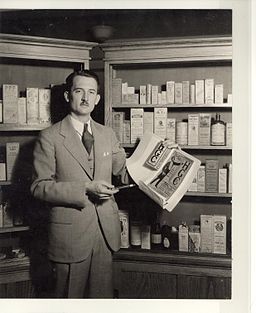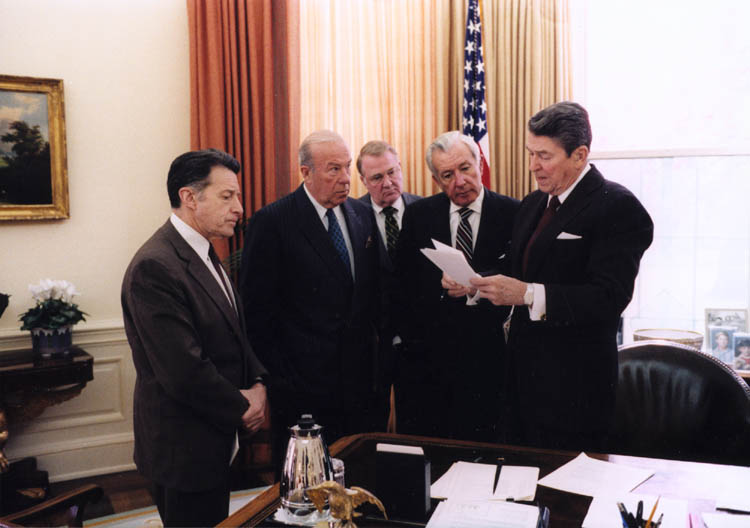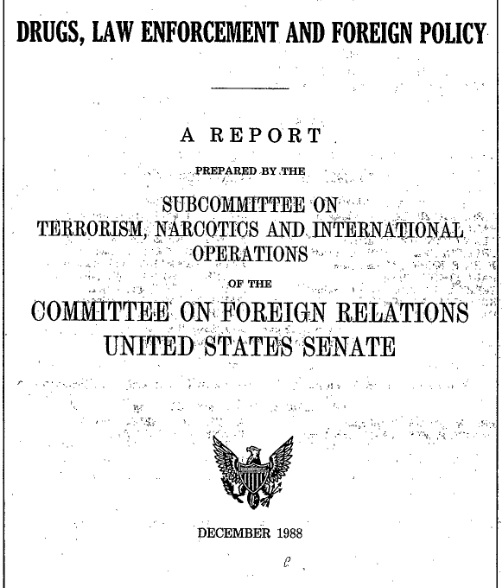Scaredy-Cats and Fraidy-Cats

The photographer’s cat rides next to the rear window in a car. Photo by Tangopaso. Even an extraordinarily calm cat should ride in a carrier of some kind within a moving vehicle.
— Techly




What has changed since then has been the increasing average age of the population and the consequent increase in demand for medicines to treat their growing health complaints. Drug manufacturers are also not above boosting demand with lengthy and frequently repeated television commercials urging prospective users to pressure their doctors into prescribing the advertised medicine. They cover the other end as well by sponsoring junkets and giveaways for doctors, nudging them toward prescribing the latest drug they have developed.
A most excellent reading by Irene Worth and John Gielgud in 1983 of T.S. Eliot’s Old Possum’s Book of Practical Cats. The entire book is presented in this video, but the part that concerns us here is the first poem, “The Naming of Cats”, which proceeds up to the 1:45 mark.
It’s a high stakes game for pharmaceutical companies that have spent millions of dollars on research and development for a drug, and then millions more on shepherding it through FDA approval, and finally marketing it. Notice how television drug ads are 60 seconds long instead of the usual 30 seconds, and how often they are repeated, particularly during the day when their target audience of older people are presumably at home watching. There’s gold in them thar hills of retirement, and pharmaceutical companies mean to get their share. Whether the residents of the golden hills are better off with the latest heavily advertised gobbledygook drug or something else, or with nothing at all, is up to them and not to marketers, no matter how warm and fuzzy the television ads portray their lives can be, to paraphrase the Rolling Stones “(I Can’t Get No) Satisfaction”, an old song the human targets of drug ads might still remember well.
— Ed. 
Adding “investigative” to Mr. Parry’s job description of journalist gives an insight into the principles he applied to his work. Aren’t all journalists investigators in some way or other? No. Some are content rewriting press releases. Robert Parry was not one of those, and for that he paid a price in getting pushed out of working for mainstream media outlets. He would never be one of those television talking heads claiming journalist credentials while making millions of dollars for asking trivial questions of celebrities about their plastic surgeries. He came by his credentials through hard work looking into things that matter.



In any discussion of medical science’s ability to increase the human life span, people seldom question the desirability of a longer life. Certainly the doctors and scientists don’t seem to question it. The assumption always is that if people were offered the possibility of living past one hundred in reasonably good health, they would grab at it eagerly. Why?
Gillian Welch and David Rawlings perform “I’ll Fly Away” on Austin City Limits on PBS in 2011.
Increasing life span is a different ethical matter for medical science than improving health for the time we generally have been allotted. Experimenting on poor creatures who likely have no interest in prolonging the lives of their tormentors, scientists are on the brink of breakthroughs that will allow people to live the length of two ordinary life spans. What for?


The right of the people to be secure in their persons, houses, papers, and effects, against unreasonable searches and seizures, shall not be violated, and no Warrants shall issue, but upon probable cause, supported by Oath or affirmation, and particularly describing the place to be searched, and the persons or things to be seized.
― Fourth Amendment to the United States Constitution.
Salt Lake City Police Detective Jeff Payne may not know the law, but on July 26 at the University of Utah Hospital he was determined to do the bidding of his watch commander, Lieutenant James Tracy, who also does not know the law (making his order illegal), to draw a blood sample from the unconscious victim of a two vehicle crash so that police could determine whether he was impaired by drugs or alcohol at the time of the crash. Payne and Tracy were prevented from violating the constitutional rights of patient William Gray by Head Nurse Alex Wubbels, who informed them that it was against hospital policy, which follows the law, to allow police to draw blood from a patient without the patient’s consent, or without a warrant or the patient being under arrest. Ms. Wubbels’s line of legal reasoning did not set well with Mr. Payne, who grew frustrated with not getting his way and finally gave in to the temptation to abuse his authority by arresting the nurse, roughly slapping handcuffs on her, and frog marching her out to his squad car.

As a case of police brutality and abuse of authority this is small potatoes compared to what police perpetrate elsewhere around the country every day and without accountability. What makes this case notable is firstly the video evidence from the cops themselves, and secondly how the obtuseness of Mr. Payne leads him to escalate to violence what should have been a simple administrative procedure. Would it be too far fetched to ask that law enforcement officers know and understand the law? Is it too much to ask that they behave with adult restraint when they don’t always get their way? Who will ultimately pay the price for Mr. Payne’s ignorance and unwarranted belligerence other than the citizens and taxpayers of Salt Lake City?
Most likely he won’t have to pay a price, considering the way police are not held personally accountable. He may even get away with pleading ignorance of the law, an excuse the Supreme Court has recently ruled can be valid for police, even though anyone else who claimed ignorance would get laughed out of court. That’s why cops like Mr. Payne behave the way they do, because at the back of their minds they know they will get away with it. His accomplice in ignorance, Lieutenant Tracy, has a bachelor’s degree in criminal justice from Columbia College of Missouri, and he is currently studying to earn a master’s degree in the same subject from the same school. Payne himself attended college at Weber State University in Ogden, Utah, where he became certified as an emergency medical technician. Maybe these schools are diploma mills, or maybe Payne and Tracy are uneducable beyond passing tests necessary to jump career hoops.
Near the end of the 1939 film The Wizard of Oz, Frank Morgan as The Wizard grants a diploma to The Scarecrow, played by Ray Bolger, while the other members of the adventure look on. Despite his newfound brainpower, The Scarecrow still recites a famous mathematics theorem incorrectly.
Or they could just be stupid. Mr. Payne also works as an emergency medical technician for Gold Cross Ambulance. In one part of the video from Mr. Payne’s body cam, he is chatting amicably with other officers, apparently unconcerned over how his bullying has made Ms. Wubbels distraught as she sits in the police cruiser several feet away, and he remarks “I wonder how this will affect my Gold Cross job. I bring patients here.” And another officer says “Yeah, I don’t think they’re [who? the hospital staff? Gold Cross? probably both] going to be very happy with it.” Mr. Payne then declares “I’ll bring them all the transients and take good patients elsewhere.” There’s a 2012 nonfiction book by the philosopher Aaron James that Mr. Payne could read in order to further his studies and perhaps gain some insights into himself, and it’s called Assholes: A Theory.
― Ed. 